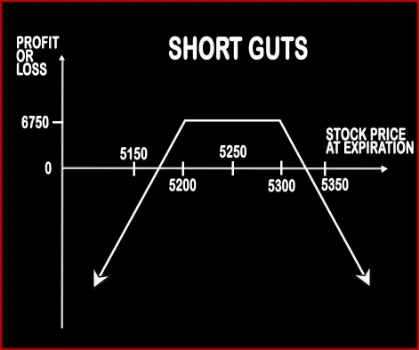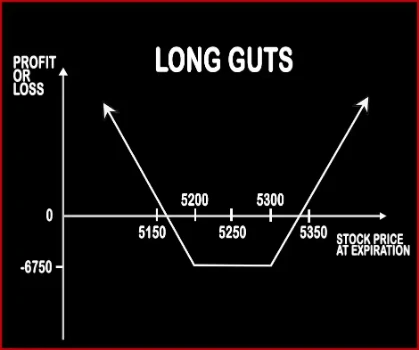Compare Strategies
| SHORT GUTS | LONG GUTS | |
|---|---|---|

|

|
|
| About Strategy |
Short Guts Option StrategyThis strategy is implemented by a trader when he is neutral on the movements and bearish on volatility i.e. he expects the stock to be range bound in the near future. This strategy involves sale of 1 ITM Call Option and 1 ITM Put Option. This strategy can be called as Credit Spread since his account is credited at the time of entering in the positions. |
Long Guts Option StrategyThis strategy is implemented by a trader when he is neutral on the movements and bullish on volatility i.e. he expects the stock to move in either direction with high magnitude. This strategy involves buying 1 ITM Call Option and 1 ITM Put Option. This strategy can be called as Debit Spread because trader’s account is debited at the time of entering the positions.< .. |
SHORT GUTS Vs LONG GUTS - Details
| SHORT GUTS | LONG GUTS | |
|---|---|---|
| Market View | Neutral | Neutral |
| Type (CE/PE) | CE (Call Option) + PE (Put Option) | CE (Call Option) + PE (Put Option) |
| Number Of Positions | 2 | 2 |
| Strategy Level | Beginners | Beginners |
| Reward Profile | Limited | Unlimited |
| Risk Profile | Unlimited | Limited |
| Breakeven Point | Upper Breakeven Point = Net Premium Received + Strike Price of Short Call, Lower Breakeven Point = Strike Price of Short Put - Net Premium Received | Upper Breakeven Point = Net Premium Paid + Strike Price of Long Call, Lower Breakeven Point = Strike Price of Long Put - Net Premium Paid |
SHORT GUTS Vs LONG GUTS - When & How to use ?
| SHORT GUTS | LONG GUTS | |
|---|---|---|
| Market View | Neutral | Neutral |
| When to use? | This strategy is implemented by a trader when he is neutral on the movements and bearish on volatility i.e. he expects the stock to be range bound in the near future. | This strategy is implemented by a trader when he is neutral on the movements and bullish on volatility i.e. he expects the stock to move in either direction with high magnitude. |
| Action | Sell 1 ITM Call, Sell 1 ITM Put | Buy 1 ITM Call, Buy 1 ITM Put |
| Breakeven Point | Upper Breakeven Point = Net Premium Received + Strike Price of Short Call, Lower Breakeven Point = Strike Price of Short Put - Net Premium Received | Upper Breakeven Point = Net Premium Paid + Strike Price of Long Call, Lower Breakeven Point = Strike Price of Long Put - Net Premium Paid |
SHORT GUTS Vs LONG GUTS - Risk & Reward
| SHORT GUTS | LONG GUTS | |
|---|---|---|
| Maximum Profit Scenario | Net Premium Received + Strike Price of Short Put - Strike Price of Short Call - Commissions Paid | Price of Underlying - Strike Price of Long Call - Net Premium Paid OR Strike Price of Long Put - Price of Underlying - Premium Paid |
| Maximum Loss Scenario | Price of Underlying - Strike Price of Short Call - Net Premium Received OR Strike Price of Short Put - Price of Underlying - Net Premium Received + Commissions Paid | Net Premium Paid + Strike Price of Long Put - Strike Price of Long Call + Commissions Paid |
| Risk | Unlimited | Limited |
| Reward | Limited | Unlimited |
SHORT GUTS Vs LONG GUTS - Strategy Pros & Cons
| SHORT GUTS | LONG GUTS | |
|---|---|---|
| Similar Strategies | Short Strangle (Sell Strangle), Short Straddle (Sell Straddle) | Short Put Ladder, Strip, Strap |
| Disadvantage | • Unlimited potential loss if the underlying stock continues to move in one direction. • High margin required. | • More commission involved than simply buying call or put option. • Expensive. |
| Advantages | • Ability to profit even when underlying asset stays stagnant. • You are already paid your full profit the moment the position is put on as this is a credit spread position. • Higher chance of ending in full profit as compared to short strangle or short straddle. | • Investors can get unlimited profit if the underlying asset goes up or down. • Ability to profit no matter if the market goes in either direction. • Limited loss. |